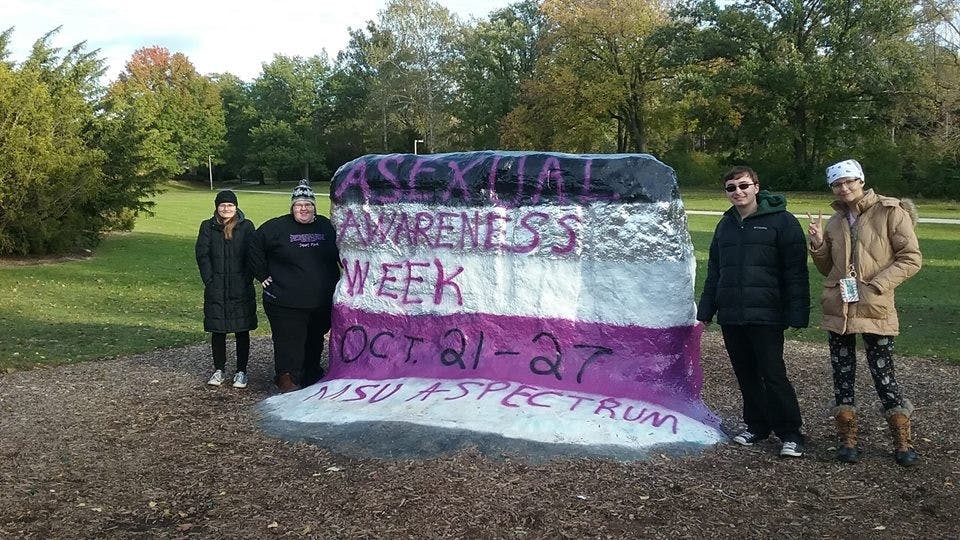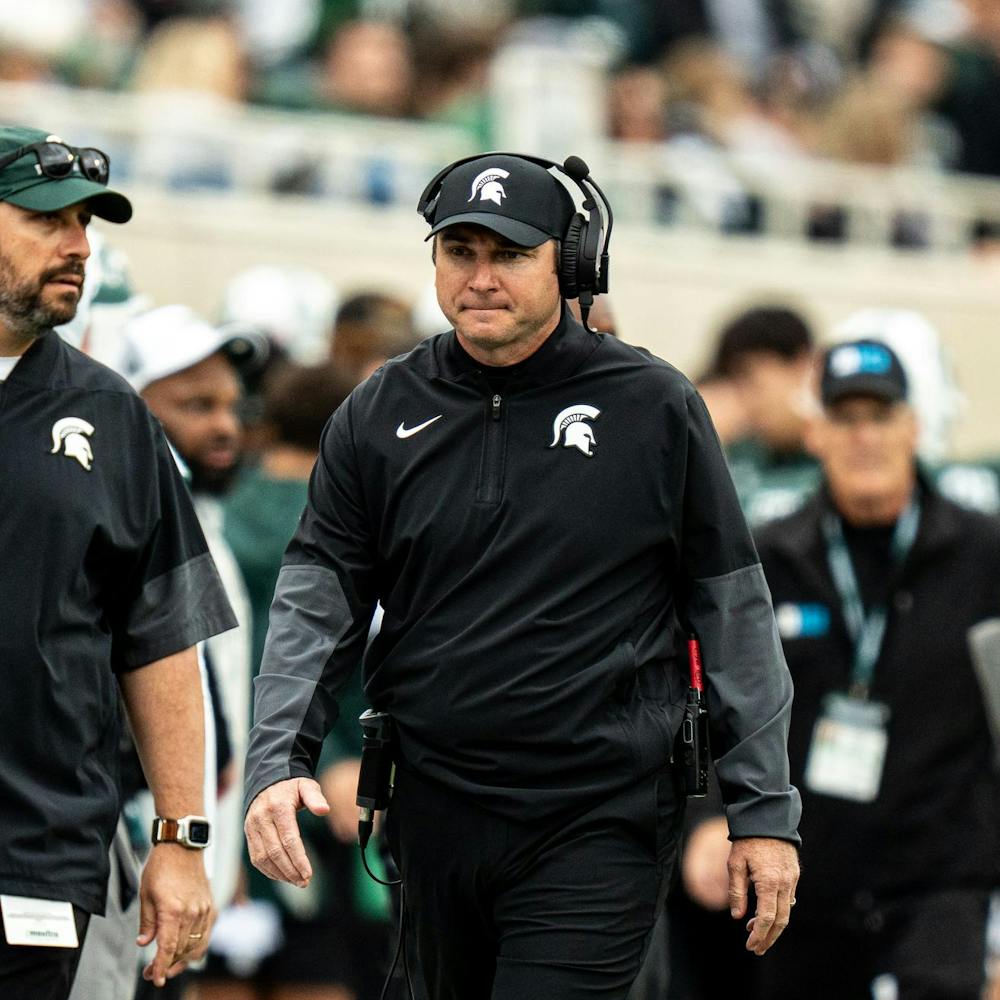“I know, personally, I probably realized I was (asexual) when I was around 14,” Jeffs said. “I really only started the process of coming out and accepting it when I was 18.”
Jeffs is now the president of A-Spectrum, an inclusive group for asexual and aromantic MSU students and their allies. A-Spectrum provides a space for students to explore the evolution of their identities.
Psychology freshman Alex Meister enjoyed their transition into college life at MSU and the chance to explore their asexual, panromantic identity.
“It’s been pretty positive. I think people are really accepting,” Meister said. “This is kind of my first time being out in a lot of different ways, so I feel like people are willing to learn even if they come from areas that don’t have that kind of representation.”
Defining Asexuality, Aromanticism and Attraction
Research on asexuality is ever-growing. Current numbers indicate asexuals make up approximately 1 percent of people, according to the Asexual Visibility and Education Network.
Within asexual and aromantic communities, common definitions encompass different forms of attraction. The concept of identity as a “spectrum” allows individual human beings to identify in varying ways, and thinking of attraction on a spectrum eliminates permanent labels.
“A lot of people tend to see asexuality, or labels in general, as very permanent now and I don’t think it used to be that way,” Jeffs said. “Now it’s like you can’t dare to be wrong or be questioning. But it’s okay to question and it’s okay to come into a space and try to work out your feelings.”
Attraction is a person’s desire or interest in someone, be it romantically or sexually. Asexuality and aromanticism exist on a spectrum, much like sexuality.
“Asexuality is a lack of sexual attraction or, because it’s a spectrum, experiencing it very rarely,” according to Jeffs. “Aromanticism is lack of romantic attraction and the spectrum that goes with that.”
Gender also exists on a spectrum. Agender describes people who don’t identify within the binary of male or female. It’s sometimes known as being gender-neutral.
Political science and economics freshman Ash Clarke identifies as agender. There are instances where others don’t always understand what that means. Clarke said they try to embrace the unknown and continue to live by their own rules.
“I don’t fit in a box,” Clarke said. “I express my identity by just being me and not trying to conform to anything. I think it’s pretty simple.”
Misconceptions about the A-Spectrum
Because they make up a smaller percentage of the population, asexual and aromantic people often find themselves being asked what their identity means.
“A lot of the time I have to explain it, which I’m fine doing, but it’s kind of frustrating a little bit, where I’m like, ‘Okay, another vocab lesson.’ But again, I don’t mind,” Meister said. “A lot of people are willing to learn.”
Support student media!
Please consider donating to The State News and help fund the future of journalism.
Some people have never heard the terminology — so they ask for it to be explained, according to Meister.
“Usually, ‘What the heck is that?’ is kind of the top thing,” Meister said.
Asexual, or ace, and aromantic, or aro, people also receive questions about the legitimacy of their identity.
“A lot of people, I think, just don’t think it’s real. They confuse it with asexual reproduction,” said Lucy Angers, a linguistics senior who identifies as both asexual and aromantic.
Stemming from the lack of education on asexual and aromantic identities, other people sometimes feel discomfort asking ace and aro people questions.
“Definitely people don’t think that it’s real and a lot of people ask really inappropriate sexual questions, like about your sex history, whether or not you masturbate, if they can ‘change you,’ that’s a big one,” Jeffs said. “It’s difficult sometimes because there’s a boundary between sharing overly personal information and still wanting to educate and help people understand.”
Other FAQ revolve around sex.
“I get asked, ‘What if your future partner wants to have sex?’ and for me personally, I’m not interested, but there’s another subset on the spectrum where people would be like, ‘Yeah, sure. Once I get to know the person I’ll be fine,’ or they do it for reproductive means,” one asexual student said.
“It’s really vulnerable being queer.”
Societal standards place an emphasis on a heteronormative model for relationships, according to Jeffs. Those who do not fit within that model face extra scrutiny.
“You deal with amatonormativity, which is that idea that everyone should strive for a single monogamous romantic relationship, as the ultimate pinnacle of society,” Jeffs said.
“That’s really what makes asexuality and aromanticism queer, because they reject the established cis, heteronormative model.”
While attempting to navigate relationships, asexual and aromantic people face questions about their own lifestyles.
“People hear about different lifestyles and immediately want to go to genitals and sex and if you wouldn’t ask a fellow straight, cis stranger, don’t ask us,” Jeffs said. “This goes for the queer community as a whole, honestly.”
An MSU student who wished to remain anonymous explained the fluidity of identifying on the asexual or aromantic spectrums.
“Asexual does not mean we don’t get crushes,” the student said. “It’s just we’re not always the most interested in the physical activities.”
Meister identified communication as an important element of navigating relationship standards with a person who is asexual.
“I have difficulty knowing if people are willing to be in a relationship with an ace person,” Meister said. “I know other people have needs and all that sort of stuff, but I’ve always been open about that with people I’ve been in relationships with.”
A-Spectrum at MSU and other resources
Jeffs founded A-Spectrum in response to an LBGT Resource Center Color Me Queer Discussion on asexuality during spring 2015. People showed up and began meeting on their own. Then, in August 2015, the group became a registered student organization.
“We were like, ‘Hey, it would be really great if we made a group on campus specifically for ace people,’” Jeffs said.
A-Spectrum at MSU meets at 6 p.m. Tuesdays in Wells Hall, Room A224 to discuss topics of asexuality, aromanticism and other issues involving gender and sexuality. In addition, they promote awareness and education about a-spectrum identities. This provides a home base for people looking to learn more about ace and aro identities.
“I’ve made so many friends and have such a good support system through (A-Spectrum). It’s really helped me feel better,” Jeffs said. “I have some mental health issues, depression, anxiety and they have really helped me with some of that.”
For students looking for a broader range of assistance and resources, MSU’s LBGT Resource Center’s doors are open, too.
“The center is definitely a community space, a physical space, for people who are of the LGBTQIA+ identities and allies, to come and just feel comfortable and get a sense of relief,” MSU Finance and Administrative Assistant Crystal King said.
The center is a multipurpose space used by students throughout the day. Events are also held in the evenings throughout the year to encourage conversation among LGBTQ students and their allies.
“We also do a lot of connecting organizations as much as we can and making sure that people have a space to feel comfortable on campus and have somewhere they can talk to someone about their issues and problems and look for resources,” King said.
Future for community at MSU
Despite confusion and prejudice toward the asexual, aromantic and agender community, MSU students are on a mission to promote awareness, education and supportive friendships on campus.
“If we could raise awareness, it would help a lot of people to feel like they are okay the way they are,” Jeffs said.
Clarke said they feel comfortable living with their agender identity at MSU.
“Campus in general and everybody here is pretty chill with my identity and accepting of it,” Clarke said.
Angers believes there is a way to eventually reach understanding and acceptance.
“I would love to just move past awareness, because it seems like we’ve been stuck there for a long time,” Angers said. “I want more people to know what asexuality is ... and I’d like to get to the point where people understand the definition and we can move on to being more welcoming to people.” Angers said.
Discussion
Share and discuss “A-spectrum student experiences on MSU’s campus” on social media.







